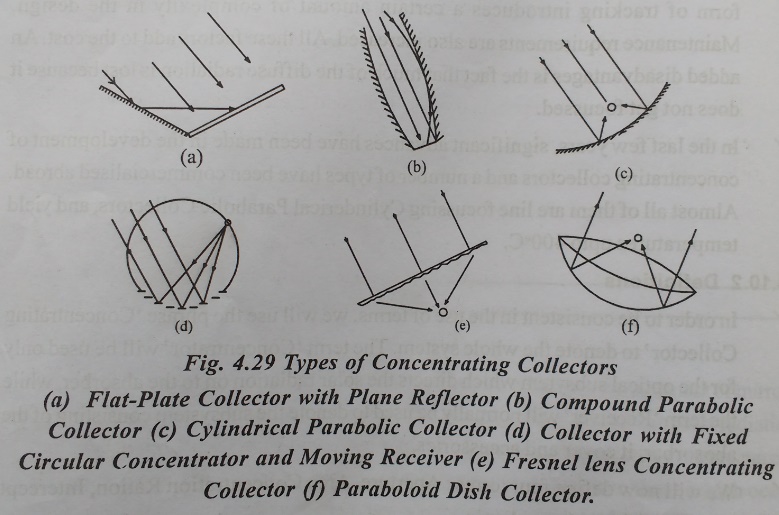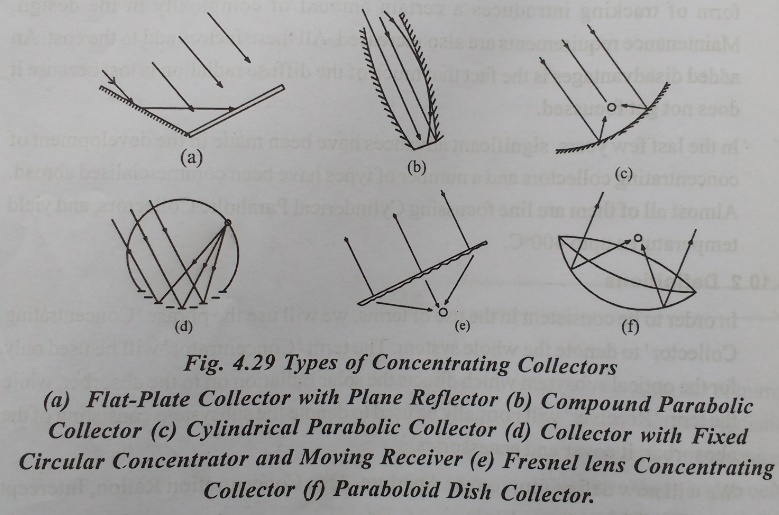Chapter: Electric Energy Generation and Utilisation and Conservation : Solar Radiation and Solar Energy Collectors
Types of Concentrating Collectors

TYPES OF
CONCENTRATING COLLECTORS

The
different types of collector geometries are shown in figure 4.29.
The
first type shown in figure 4.29(a) is a flat-plate collector with adjustable
minors at the edges to reflect radiation on to the absorber plate, It is simple
in design, has a concentration ratio a little above unity and is useful for
giving temperatures about 20oC or 30 oC higher than those
obtained from a flat-plate alone.
A
compound parabolic concentrating collector (CPC) is shown in figure. The
concentrator consists of curved segments which are parts of two parabolas. Like
the first type, this collector is also non-imaging. The type concentration
ratio is moderate and imaging. The concentration ration is moderate and
generally ranges from 3 to 10. The main advantage of the compound parabolic
collector is that it has a high acceptance angle and consequently requires only
occasional tracking. In addition, its concentration ratio is equal to the
maximum value possible for a given acceptance angle.
The
next type collector (figure 4.29(c)) is a cylindrical parabolic collector in
which the image is formed on the focal axis of the parabola. Many commercial
versions of this type are now available.
Unlike
the cylindrical parabolic collector in which the concentration has to rotate in
order to track the sun, the type shown in figure 4.29(d) has a fixed
concentrator and a moving receiver. The concentrator is an array of long,
narrow, flat mirror strips fixed along the cylindrical surface. The strip
produce a narrow line image which follows a circular path as the sun moves.
This path is on the same circle on which the mirror strips are fixed. Thus, the
receiver has to be moved along the circular path in order to track the sun.
Concentration
is also achieved by using lenses. The most commonly used device is the Fresnel
lens shown in figure 4.29(e). The one shown in the figure is a thin sheet, flat
on one side with fine longitude grooves on the other. The angles of these
grooves are such that radiation is brought to a line focus. The lens is usually
made of extruded acrylic plastic sheets. Line focussing collectors like the one
shown in figure 4.29(c,d,e). Usually have concentration rations between 10 to 80
and yield temperature between 150 to 400.
In
order to achieve higher concentration ratios and temperatures it becomes
necessary to have point focussing rather than line focussing. A sketch is shown
in figure4.29(f). Such collectors can have concentration ratios ranging from
100 to a few thousand and have yielded temperatures upto 2000o.
However, from the point of view of the mechanical design, there are limitations
to the size of the concentrator and hence the amount of energy which can be
collected by one dish. Commercial versions have been built with dish diameter
up to 17m. In order to collect larger amounts of energy at one point, the
central receiver concept has been adopted. In this case, beam radiation is
reflected from a number of independently controlled mirrors called ŌĆśHeliostatsŌĆÖ
to a central receiver located at the top of a tower.
ŌĆ£RablŌĆØ
has show that for a given acceptance angle (2qa)
the maximum possible concentration ratio of a two-dimensional (line-focus)
concentrator is

For
a three dimensional (point - focus) concentrator, has shown that,

The
half-angle subtended by the earth is 0.267o. Substituting this value
in equation 4.104 and 4.105, we see that the maximum value of concentration
ratio for a line-focus concentration is 215 and for a point-focus concentrator,
it is 46000. In actual system, the values of concentration ratio are much
lower, since the acceptance angle needs to be greater than 0.267o
for a number of reasons. These include tracking errors, imperfections in the
reflecting or refracting component of the concentrator, mechanical misalignment
between the concentrator and the receiver etc.
Related Topics